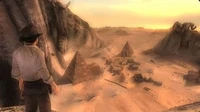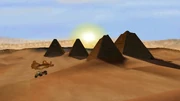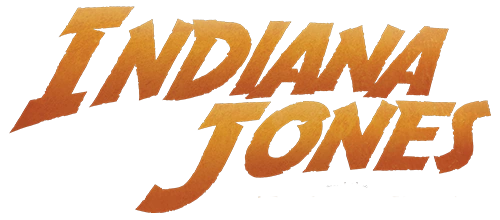Anglo-Egyptian Sudan, (present-day Sudan and South Sudan) was a country in northeastern Africa. The Nile River flows through the country, north to its border with Egypt. Much of its early history is connected with the history of Egypt following their colonization into the area then known as Nubia in 2000 BC, and its position in the Arab world.
In the first half of the twentieth century, Sudan was a de facto possession of the United Kingdom, though officially it was called Anglo-Egyptian Sudan and was technically administered by a governor appointed by the Egyptians under British consent. Sudan gained independence from the United Kingdom in 1956.
Adventures in Sudan[]
In ancient times, one of the Disciples of Marduk, Nub, Nebuchadnezzar's chief technician, came to the region with his part of the Infernal Machine. Finding King Solomon's mines under the city of Meroë, he built elaborate defences for the part as well as a tomb for himself. Nub also became the first king of the people who would later be called Nubians and the Egypto-Sudanese region "Nubia" is named in his honor.[1]
In 1923, a German company named Heinrich Hörner Aktiengesellschaft, led by Heinrich Hörner, set up a mining operation in Meroë and named the site König Salomons Grube (German: King Solomon's Mines). The site was seemingly abandoned sometime long before 1947.[1]

Indiana Jones in Sudan in 1939.
In 1939, Indiana Jones journeyed to Sudan to recover relics from Nubian pyramids before they could be scavenged by grave robbers. Reaching the Sudan Temple, he discovered that a Nazi digging team had set up camp at the base of the structure, and found a back way into the temple. After recovering the Ram's Head Bust, Jones was confronted by his former classmate, Magnus Völler, who took the treasure from him at gunpoint. Thinking fast, Jones tossed the artifact at a soldier, who caught the relic, but nearly fell into a pit, prompting Völler to try to rescue the relic. Jones sealed his attackers inside the temple, and ran into the camp, where he fought against several German desert commandos before escaping in a truck. Leaping from the truck onto a World War I-era German biplane taking off, Jones commandeered the aircraft and flew through a maze of narrow canyons while being shot at by Nazi Messerschmitt Bf-109s. Exiting the canyons, Jones flew to freedom and began searching for his old mentor, Charles Kingston. Jones had recovered many relics form the site including the Gold Ram's Head, the Limestone Tablet and the Nubian Bust.[2] Indy also recovered the Nubian Plate, a round plate, set upright on two legs. Its design featured several concentric rings with simple patterns of dots or markings, and a small recess in the centre. It was hidden in the temple. Indy recovered the plate after solving a puzzle regarding different coloured flames in the temple. He discovered that the plate was remarkably preserved, and speculated that at least one ring of the plate was related to the Tang Dynasty of China. Jones made notes about the treasure and how he discovered its hiding place.[3]
At some point in time, German archaeologist Magnus Völler visited König Salomons Grube as he had several of Solomon's Jewels on board his personal Zeppelin, the Odin, in 1939. Indiana Jones would recover the Jewels that same year.[4]

Indy drives to Meroe in a Jeep in 1947
In 1947, Indiana Jones travelled to the pyramids city of Meroë to search for one part of Marduk's Infernal Machine. Indy fought of a pack of spotted hyenas that made the ruins their home. Jones, with the help of a Nubian Boy, found his way into König Salomons Grube, finding the remains of Heinrich Hörner who was an unburied skeleton with his face-up in a ravine near the mine's entrance. The skeleton was clothed in a beige safari uniform and a pith helmet. Indy found a silver-coloured pocket watch his remains, inscribed with Hörner's name. Jones unlocked the huge metal door to the main mine entrance and reactivated the mine carts' electrical system. Pursued by Vrach Gennadi Volodnikov and a troop of Russian Spetsnaz, Jones explored deep into the mines, discovered some of Solomon's Jewels, completed its enormous puzzle requiring the discovery of a red, blue and green gem and a special item called the Eye of Horus and then quietly entered Nub's Tomb which lay beneath the mines. Within the tomb, Jones unexpectedly found still-functioning, highly advanced robots that had been presumably designed by Nub himself as guardians against intruders. Navigating the complex labyrinthine corridors of the tomb, Jones eventually came to the inner crypt in which Nub's personal sarcophagus was found, though it was very plain in appearance and Nub's own corpse inside was not mummified. There, Jones also discovered the fourth and final piece of the Infernal Machine as well as a single ruby gem, called "Nub's Eye". Jones placed the eye in a socket on the floor. This then opened up a floor panel, raising an ancient robot guardian of the tomb. It chased him in the room around Nub's sarcophagus. Jones successfully deactivated it by electrocution, luring it across various electrified floor panels and jumping from its head across to the crypt's only exit with the fourth piece in hand. Exiting the tomb, Jones encountered Sophia Hapgood and Simon Turner, who took the parts from Jones and left, despite Gennadi Volodnikov's insistence that Turner and Hapgood were gangsters. Jones then followed Hapgood and Turner to Babylon.[1]
Artifacts[]
- Ram's Head Bust
- Gold Ram's Head
- Limestone Tablet
- Nubian Bust
- Nubian Plate
- Solomon's Jewels
- Eye of Horus
- Nub's Eye
Notable Sudanese[]
Locations in Sudan[]
Appearances[]
- British East Africa, September 1909 comic (On map)
 The Further Adventures of Indiana Jones – "The Harbingers" (Mentioned only)
The Further Adventures of Indiana Jones – "The Harbingers" (Mentioned only)- Indiana Jones and the Last Crusade (Mentioned only)
- Indiana Jones and the Staff of Kings (Wii and PS2 versions)
- Indiana Jones and the Staff of Kings Scavenger Hunt
- Indiana Jones and the Infernal Machine
Sources[]
- The World of Indiana Jones
- Indiana Jones and the Lands of Adventure
- Indiana Jones Magic & Mysticism: The Dark Continent
- Indiana Jones and the Infernal Machine adventure guide/instruction booklet
- Indiana Jones: The Ultimate Guide
